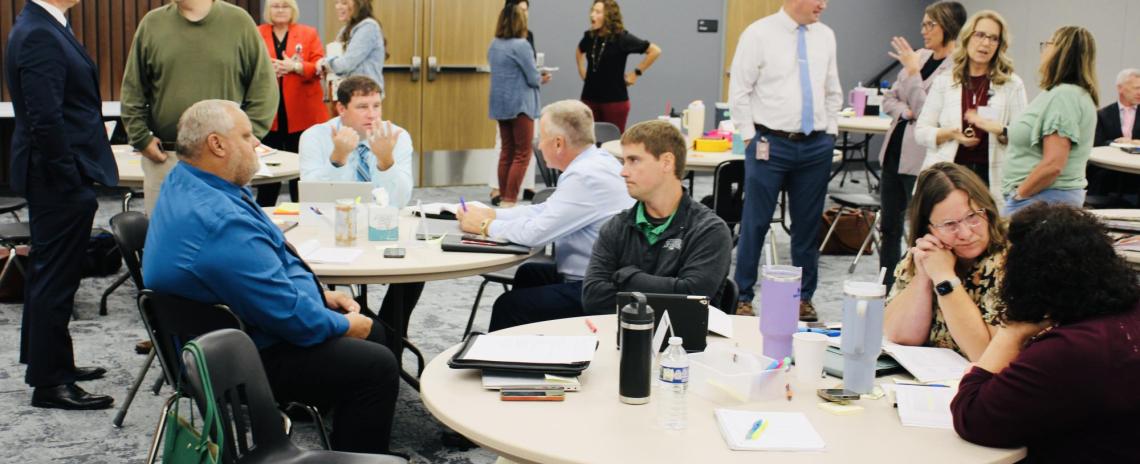Bridging the Gap: Seeing ESU 15’s Plan to Elevate Literacy in Action
Bridging the Gap: Seeing ESU 15’s Plan to Elevate Literacy in Action
By Tyler Dahlgren
For decades, studies have shown that the Science of Reading works for the majority of students. And yet, there has been an ongoing and concerning dip in reading proficiency scores across the country.
It’s a conundrum, one the Nebraska Department of Education zoned in on remedying when it released the Nebraska Literacy Project last year. One of the primary goals of the project, hoisted by the federal five-year, $55 million Comprehensive Literacy State Development (CLSD) Grant, is to increase third grade proficiency on the NSCAS ELA to 75-percent by 2030.
At NCSA’s Administrators’ Days last July, Educational Service Unit 15 administrator Phillip Picquet and professional development coordinator Angie Dickey listened to Nebraska Commissioner of Education Dr. Brian Maher deliver a keynote centered on NDE’s literacy initiative. They knew they needed to put a plan in place.
ESU 15 had itself a bridge to build, and Dickey knew where to start.

“Angie came in and said, ‘We’re going to need to have some instructional coaching for administrators and lead teachers, so that once the literacy initiatives, interventions and the core reading programs are implemented, we’ll be equipped to move those forward in a sustainable way,” Picquet recalled.
The idea to start at the top was an easy one to make.
“Phillip and I agreed that we had to start with leadership, because we knew our school districts weren’t going to take their best teachers out of their classrooms to be instructional coaches,” Dickey said. “Our administrators see things through the lens of evaluators, but not necessarily coaches. We felt we needed to get them educated on that part in order to build instruction.”
Instructional Coaching Group (ICG) consultant Dr. Mary Webb was at McCook Community College on Sep. 22 for the first of two ICG sessions titled “Unwrapping the Definitive Guide to Instructional Coaching.” In attendance were school leaders from most of the districts ESU 15 serves. The first workshop, she explained, was about building a solid foundation.

The visual, a room full of superintendents and principals taking part in a highly-interactive and energetic workshop, was a fun one. For them, it was a rare opportunity for some professional development with colleagues from the area. Webb said she hoped participants left McCook with some new tools, organized and not overwhelmed.
“I don’t want them walking out of here feeling like there’s fifty items on a to-do list to take care of,” Webb said. “You keep it bite-sized, just like they do with their teachers. You want them to have bite-sized chunks they feel like they can manage and accomplish. It’s that way in coaching, too.”
What this will all look like, it’s too early to tell, but ESU 15 has a plan in place that aligns with the department’s.
“We are building the plane as we fly the plane,” Dickey said — a fitting image for a rollout that emphasizes sustainable classroom instruction, teacher buy-in, and the coaching mantra Dr. Webb calls the “go slow to go fast” approach.
“You can’t just say, ‘I’m going to start coaching,’ without having a foundation and a systemic approach in place,” Webb said. “That’s a big undertaking, shifting an entire school, but it really boils down to building the teachers. Giving building leaders some new strategies and skills and then helping them refine what they’ve acquired naturally, that’s what we hope they take away from today.”

Jim Knight’s ICG model for instructional coaching has been around for more than 20 years, and his research has been a valuable resource for even longer. Everybody in professional development has heard of Jim Knight, and ESU 15 didn’t have to do much searching when deciding who to bring in.
“The Florida Center for Reading Research, the AIMS Institute and several other institutions have built many of their models after Jim Knight’s model,” Dickey said. “He’s very influential and proven in the area of instructional coaching.”
It’s important, Dickey said, for administrators to be in-tune with what’s happening in their buildings. They don’t need to be the expert in the room when it comes to the Science of Reading, she explained, but they do need to understand the data and the delivery.
“That will help them put the correct leaders in place to drive instruction,” she added.
Other staff from ESU 15 attended the session as well. Their expertise, Picquet said, is another important component to the equation. They’ll have a seat at the table and will be ready to provide support when needed, as they always are.
“They’re in those school school districts to be a team player,” Picquet said of his staff. “So when districts are having conversations around instructional coaching and literacy, or when they’re working one-on-one with an instructional coach, be it an administrator or a teacher, they’ll be ready for any questions they might have.”



